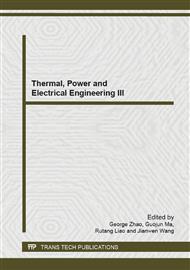[1]
Doolla S, Bhatti T S. Automatic generation control of an isolated small-hydro power plant [J]. Electric Power Systems Research. 2006, 76(9): 889-896.
DOI: 10.1016/j.epsr.2005.11.002
Google Scholar
[2]
Castronuovo E D, Peas Lopes J A. On the optimization of the daily operation of a wind-hydro power plant [J]. Power Systems, IEEE Transactions on. 2004, 19(3): 1599-1606.
DOI: 10.1109/tpwrs.2004.831707
Google Scholar
[3]
Paish O. Small hydro power: technology and current status [J]. Renewable and sustainable energy reviews. 2002, 6(6): 537-556.
DOI: 10.1016/s1364-0321(02)00006-0
Google Scholar
[4]
Kaldellis J K, Vlachou D S, Korbakis G. Techno-economic evaluation of small hydro power plants in Greece: a complete sensitivity analysis [J]. Energy Policy. 2005, 33(15): 1969-(1985).
DOI: 10.1016/j.enpol.2004.03.018
Google Scholar
[5]
Hu Hua,Wu Shan,Xia Xiang,et al.Computing the maximum penetration level of multiple distributed generators in distribution network taking into account voltage regulation constraints [J]. Proceedings of the CSEE, 2006, 26(19): 13-17 (in Chinese).
Google Scholar
[6]
Xia Xiang, Huang Wei, Xu Xianghai, et al. Penetration level calculation taking into consideration the unit commitment of small hydro power [J]. Automation of Electric Power Systems, 2006, 30 (22): 48-52 (in Chinese).
Google Scholar
[7]
Kim T E, Kim J E. A method for determining the introduction limit of distributed generation system in distribution system [C]. Vancouver, BC: (2001).
Google Scholar
[8]
GUO Jinming, LI Xinran, DENG Wei, et al. Comprehensive Optimal Allocation of Intermittent Distributed Generation and Reactive Power Compensation Based on Bi-level Planning [J]. Proceedings of the CSEE, 2013(28): 25-33 (in Chinese).
DOI: 10.1109/isgt-asia.2012.6303142
Google Scholar
[9]
YU Kun, CAO Yijia, CHEN Xingying, et al. Reactive power and voltage optimization of the district grid with distributed generation [J]. Automation of Electric Power Systems, 2011, 35(8): 1-5 (in Chinese).
Google Scholar
[10]
ZHANG Li, XU Yuqin, WANG Zengping, et al. Reactive power optimization for distribution system with distributed generators [J]. Transactions of China Electrotechnical Society, 2011, 26(3): 168-174 (in Chinese).
Google Scholar
[11]
Zhaojian W, Ying C, Shengzhou K, et al. Optimal design of isolated microgrid considering run-time load controllability [C]. Xi'an: (2013).
Google Scholar


